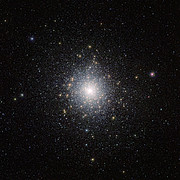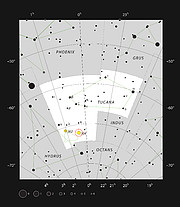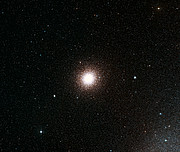Comunicato Stampa
Un miscuglio di stelle esotiche
Un nuovo scatto di VISTA immortala l'ammasso stellare 47 Tucanae
10 Gennaio 2013
Questa nuova immagine infrarossa del telescopio VISTA dell'ESO mostra l'ammasso globulare 47 Tucanae con un dettaglio sorprendente. Questo ammasso contiene milioni di stelle e molte tra quelle annidate al suo interno ci appaiono esotiche e mostrano proprietà insolite. Studiare gli oggetti all'interno di ammassi come 47 Tucanae ci aiuta a capire meglio come queste strane sfere si formano e interagiscono. Questa immagine è molto nitida e profonda grazie alla dimensione, sensibilità e ubicazione di VISTA, all'Osservatorio del Paranal dell'ESO in Cile.
Gli ammassi globulari sono grandi nubi sferiche di stelle vecchie legate dalla gravità reciproca. Orbitano intorno al nucleo delle galassie, così come i satelliti orbitano intorno alla Terra. Questi grumi di stelle contengono pochissima polvere e gas - si pensa che la maggior parte sia stata soffiata via dall'ammasso dai venti stellari e dalle esplosioni delle stelle in esso contenute, o strappata dal gas interstellare che interagisce con l'ammasso. Tutto il materiale rimasto si è fuso a formare stelle miliardi di anni fa.
Gli ammassi globulari accendono l'interesse degli astronomi - 47 Tucanae, noto anche come NGC 104, è un ammasso globulare enorme e antico, a circa 15 000 anni luce da noi, e contiene molte stelle e sistemi stellari bizzarri e interessanti.
Ubicato nella costellazione australe del Tucano, 47 Tucanae orbita nella Via Lattea. La sua dimensione di circa 120 anni luce è così ampia che, nonostante la distanza, ci appare grande quasi come la Luna piena; contiene milioni di stelle ed è tra i più brillanti e massicci ammassi globulari noti ed è visibile a occhio nudo [1]. Tra la massa vorticosa di stelle al centro si trovano molti sistemi interessanti, tra cui sorgenti di raggi X, stelle variabili, stelle vampiro, stelle "normali" inaspettatamente brillanti note come "vagabonde blu" (o "blue stragglers"; eso1243) e piccoli oggetti noti come "pulsar al millisecondo", stelle morte che ruotano molto rapidamente [2].
Le giganti rosse, stelle che hanno esaurito il combustibile nel nucleo e si sono quindi gonfiate, sono distribuite ovunque in questa immagine di VISTA e sono facili da individuare, poichè risplendono di un colore ambra scuro che si staglia sullo sfondo bianco-giallo delle stelle. Il nucleo densamente affollato fa da contrasto alle regioni più esterne dell'ammasso meno dense, mentre sullo sfondo sono visibili molte stelle della Piccola Nube di Magellano.
Questa immagine è stata ottenuta con il telescopio dell'ESO VISTA (Visible and Infrared Survey Telescope for Astronomy) durante la survey delle Nubi di Magellano, due delle galassie più vicine a noi. 47 Tucanae, anche se molto più vicino delle Nubi, si trova per caso in proiezione davanti alla Piccola Nube di Magellano (eso1008) ed è stata ripresa durante la survey.
VISTA è il più grande telescopio al mondo dedicato alle survey del cielo. Ubicato all'Osservatorio del Paranal dell'ESO, in Cile, questo telescopio infrarosso, con il suo grande specchio, l'ampio campo di vista, i rivelatori molto sensibili rivela una nuova prospettiva del cielo australe. Usando una combinazione di immagini molto nitide nell'infrarosso - come quella di VISTA qui mostrata - e osservazioni in luce visibile gli astronomi possono studiare in gran dettaglio il contenuto e la storia di oggetti come 47 Tucanae.
Note
[1] Ci sono più di 150 ammassi globulari in orbita intorno al centro della nostra galassia. 47 Tucanae è il secondo per massa, dopo Omega Centauri (eso0844).
[2] Le pulsar al millisecondo sono versioni incredibilmente più veloci delle pulsar normali, resti stellari altamente magnetizzati in rapidissima rotazione che emettono impulsi di radiazione mentre girano. Sono 23 le pulsar al millisecondo note in 47 Tucanae - più di tutti gli altri ammassi globulari tranne uno, Terzan 5 (eso0945).
Ulteriori Informazioni
L'ESO (European Southern Observatory, o Osservatorio Australe Europeo) è la principale organizzazione intergovernativa di Astronomia in Europa e l'osservatorio astronomico più produttivo al mondo. È sostenuto da 15 paesi: Austria, Belgio, Brasile, Danimarca, Finlandia, Francia, Germania, Gran Bretagna, Italia, Olanda, Portogallo, Repubblica Ceca, Spagna, Svezia, e Svizzera. L'ESO svolge un ambizioso programma che si concentra sulla progettazione, costruzione e gestione di potenti strumenti astronomici da terra che consentano agli astronomi di realizzare importanti scoperte scientifiche. L'ESO ha anche un ruolo di punta nel promuovere e organizzare la cooperazione nella ricerca astronomica. L'ESO gestisce tre siti osservativi unici al mondo in Cile: La Silla, Paranal e Chajnantor. Sul Paranal, l'ESO gestisce il Very Large Telescope, osservatorio astronomico d'avanguardia nella banda visibile e due telescopi per survey. VISTA, il più grande telescopio per survey al mondo, lavora nella banda infrarossa mentre il VST (VLT Survey Telescope) è il più grande telescopio progettato appositamente per produrre survey del cielo in luce visibile. L'ESO è il partner europeo di un telescopio astronomico di concetto rivoluzionario, ALMA, il più grande progetto astronomico esistente. L'ESO al momento sta progettando l'European Extremely Large Telescope o E-ELT (significa Telescopio Europeo Estremamente Grande), un telescopio da 39 metri che opera nell'ottico e infrarosso vicino e che diventerà "il più grande occhio del mondo rivolto al cielo".
Links
Contatti
Richard Hook
ESO, La Silla, Paranal, E-ELT & Survey Telescopes Press Officer
Garching bei München, Germany
Tel.: +49 89 3200 6655
Cell.: +49 151 1537 3591
E-mail: rhook@eso.org
Anna Wolter (press contact Italia)
Rete di divulgazione scientifica dell'ESO
e INAF-Osservatorio Astronomico di Brera
Milano, Italy
Tel.: +39 02 72320321
E-mail: eson-italy@eso.org
Sul Comunicato Stampa
| Comunicato Stampa N": | eso1302it |
| Nome: | NGC 104 |
| Tipo: | Milky Way : Star : Grouping : Cluster : Globular |
| Facility: | Visible and Infrared Survey Telescope for Astronomy |
| Instruments: | VIRCAM |
Our use of Cookies
We use cookies that are essential for accessing our websites and using our services. We also use cookies to analyse, measure and improve our websites’ performance, to enable content sharing via social media and to display media content hosted on third-party platforms.
ESO Cookies Policy
The European Organisation for Astronomical Research in the Southern Hemisphere (ESO) is the pre-eminent intergovernmental science and technology organisation in astronomy. It carries out an ambitious programme focused on the design, construction and operation of powerful ground-based observing facilities for astronomy.
This Cookies Policy is intended to provide clarity by outlining the cookies used on the ESO public websites, their functions, the options you have for controlling them, and the ways you can contact us for additional details.
What are cookies?
Cookies are small pieces of data stored on your device by websites you visit. They serve various purposes, such as remembering login credentials and preferences and enhance your browsing experience.
Categories of cookies we use
Essential cookies (always active): These cookies are strictly necessary for the proper functioning of our website. Without these cookies, the website cannot operate correctly, and certain services, such as logging in or accessing secure areas, may not be available; because they are essential for the website’s operation, they cannot be disabled.
Functional Cookies: These cookies enhance your browsing experience by enabling additional features and personalization, such as remembering your preferences and settings. While not strictly necessary for the website to function, they improve usability and convenience; these cookies are only placed if you provide your consent.
Analytics cookies: These cookies collect information about how visitors interact with our website, such as which pages are visited most often and how users navigate the site. This data helps us improve website performance, optimize content, and enhance the user experience; these cookies are only placed if you provide your consent. We use the following analytics cookies.
Matomo Cookies:
This website uses Matomo (formerly Piwik), an open source software which enables the statistical analysis of website visits. Matomo uses cookies (text files) which are saved on your computer and which allow us to analyze how you use our website. The website user information generated by the cookies will only be saved on the servers of our IT Department. We use this information to analyze www.eso.org visits and to prepare reports on website activities. These data will not be disclosed to third parties.
On behalf of ESO, Matomo will use this information for the purpose of evaluating your use of the website, compiling reports on website activity and providing other services relating to website activity and internet usage.
Matomo cookies settings:
Additional Third-party cookies on ESO websites: some of our pages display content from external providers, e.g. YouTube.
Such third-party services are outside of ESO control and may, at any time, change their terms of service, use of cookies, etc.
YouTube: Some videos on the ESO website are embedded from ESO’s official YouTube channel. We have enabled YouTube’s privacy-enhanced mode, meaning that no cookies are set unless the user actively clicks on the video to play it. Additionally, in this mode, YouTube does not store any personally identifiable cookie data for embedded video playbacks. For more details, please refer to YouTube’s embedding videos information page.
Cookies can also be classified based on the following elements.
Regarding the domain, there are:
- First-party cookies, set by the website you are currently visiting. They are stored by the same domain that you are browsing and are used to enhance your experience on that site;
- Third-party cookies, set by a domain other than the one you are currently visiting.
As for their duration, cookies can be:
- Browser-session cookies, which are deleted when the user closes the browser;
- Stored cookies, which stay on the user's device for a predetermined period of time.
How to manage cookies
Cookie settings: You can modify your cookie choices for the ESO webpages at any time by clicking on the link Cookie settings at the bottom of any page.
In your browser: If you wish to delete cookies or instruct your browser to delete or block cookies by default, please visit the help pages of your browser:
Please be aware that if you delete or decline cookies, certain functionalities of our website may be not be available and your browsing experience may be affected.
You can set most browsers to prevent any cookies being placed on your device, but you may then have to manually adjust some preferences every time you visit a site/page. And some services and functionalities may not work properly at all (e.g. profile logging-in, shop check out).
Updates to the ESO Cookies Policy
The ESO Cookies Policy may be subject to future updates, which will be made available on this page.
Additional information
For any queries related to cookies, please contact: pdprATesoDOTorg.
As ESO public webpages are managed by our Department of Communication, your questions will be dealt with the support of the said Department.





